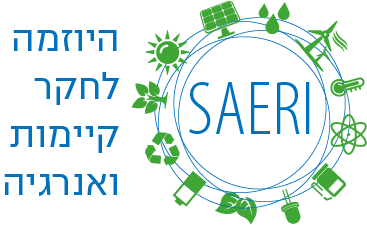מחקר
2015/16 Cycle
-
Biofuels
We take a multidisciplinary approach aimed at addressing major challenges in biomass production (Prof. Abraham Levy), analysis, design (Profs. Ron Milo and Asaph Aharoni) and processing, from the deconstruction of the cellulosic biomass into sugars (Prof. Ed Bayer), to fermentation into alcohol (Prof. Naama Barkai).
We used a variety of tools from genetics and genomics (Levy and Barkai), biochemistry (Bayer), computational and microbial biology for pathway design (Milo) and sophisticated advanced analytical techniques for biomass composition analyses (Aharoni). All the projects have accomplished significant achievements towards the development of new generations of biofuels that will not compete with food.
-
Photovoltaic Research
Profs. Gary Hodes and David Cahen focus on high voltage photovoltaic cells for use in tandem solar cells and photochemical production of chemicals. Very early in the project, hybrid perovskite photovoltaic cells (most commonly CH3NH3PbI3) burst on the scene and are now a major research area with their teams and in the world in general.
In the non-perovskite work, they showed how the work function (an important property for photovoltaic cells and all electronic devices) of zinc oxide (ZnO) could be tuned over a large range by adsorption of molecules; and explained how surface oxidation of cadmium selenide (CdSe) nanocrystals increased the photovoltage of cells based on this material.
Prof. Boris Rybtchinski investigated the crystallization parameters relevant to fabrication of perovskite materials based on CH3NH3PbI3 and CH3NH3PbBr3. In collaboration with Profs. Hodes and Cahen, they found that the addition of PbCl2 to the solutions used in the perovskite synthesis has a remarkable effect on the end product, because PbCl2 nanocrystals are present during the fabrication process, acting as heterogeneous nucleation sites for the formation of perovskite crystals in solution. This conclusion was based on scanning electron microscope (SEM) studies, synthesis of perovskite single crystals, and on cryo-TEM (transmission electron microscope) imaging of the frozen mother liquid. Their studies also included the effect of different substrates and substrate temperatures on the perovskite nucleation efficiency.
In view of these findings, they optimized the procedures for solar cells based on lead bromide perovskite, resulting in 5.4% efficiency at a Voc of 1.24 V, improving the efficiency in this class of devices. These findings have been published in a collaborative paper (Tidhar, Yaron; Edri, Eran; Weissman, Haim; Zohar, Dorin; Hodes, Gary; Cahen, David; Rybtchinski, Boris; Kirmayer, Saar. Crystallization of Methyl Ammonium Lead Halide Perovskites: Implications for Photovoltaic Applications. J. Am. Chem. Soc. 2014, 136, 13249–13256). Importantly, in this project, a cryo- TEM methodology was developed for imaging organic solutions used for fabricating solar devices.
In addition, they investigated the influence of HTL/perovskite interfaces on the performance of MAPbBr3-based devices, unraveling details of morphological and electronic changes upon interaction of organic HTLs with perovskite surface. They discovered that simple organic salts in combination with dielectric polymers can lead to relatively efficient (4%) solar cells, underlying the possibility that perovskite cells may not need an electronically active HTL. They also obtained insights into the electronic properties of the devices using UPS. A manuscript describing this work is in preparation.
Prof. Leeor Kronik developed new theoretical approaches to extend density functional theory for evaluating new photovoltaic materials. These efforts have recently been extended to the important case of the optical properties of solid-state materials. In parallel, Prof. Kronik has studied the structural properties of hybrid organic-inorganic perovskites, an exciting new class of solar cell materials. His work exposed the importance of dispersive interactions in these materials and revealed the possibility for hydrogen migration in them.
-
Optics Research
The ability of Prof. Dan Oron and his group to design and synthesize novel nanoscale semiconductor materials enabled them to develop a new class of nonlinear upconversion materials exhibiting relatively efficient photon upconversion. The group has also studied the use of compound semiconductor nanocrystals in photovoltaic cells either as sensitizers or in order to optimize the current-voltage characteristics by modification of the band alignment within the cell upon photoexcitation via the concept of photoinduced dipoles. The type-II nanocrystal sensitized system first studied by the Oron group has recently led to the highest efficiency semiconductor sensitized solar cell demonstrated, reaching nearly 8%. In parallel, Oron’s group has collaborated with the group of G. Frey (Technion) on the topic of hybrid organic-inorganic photovoltaics.
The main challenge we face today is enhancing the efficiency and simplifying the fabrication of upconversion nanostructures. We are approaching this by harnessing self-assembly of simple nanocrystalline building blocks rather than a multi-step synthesis of complex ones.
Another front where we are currently struggling to make progress is fabrication of intermediate band sensitized solar cells, where a proof-of principle experiment was successful, but where better control over the system is necessary to obtain quantitative results.
Work in Prof. Yehiam Prior’s group focused on the enhancement of nonlinear optical interactions by plasmonic cavity antennae. It was shown that nanocavities perform very differently from the more conventional nanoparticle antennae due to longer range coupling between them. This led to the development of new structures to be used for enhancement of second harmonic generation, by taking advantage of the coupling phenomenon. More recently, the group has shown that nanocavity arrays can be tailored for enhancement of the more general nonlinear process of four-wave mixing, and that spectral tuning is readily achievable by modifying the geometrical parameters of the array. All these ‘global’ nonlinear optical measurements were supplemented by both state-of-the art local measurements and detailed numerical simulations.
The main challenge we are faced with today is the generalization and optimization of the enhancement process. There are many parameters to consider such as film thickness and composition, cavity size and structural periodicities, shapes with more complex symmetries, coupled cavities of different degree of coupling, and quite a few other parameters. Like many other examples, optimization in a multi-dimensional space is rather complex and one often resorts to computer algorithms and loses physical insight.
Prof. Nir Davidson and his group focused on concentration of solar radiation close to the thermodynamic limit using the principle of phase space conservation. We applied this principle to compact concentrations based on reflective optical elements where chromatic aberrations do not exist. Specifically, a 3 mirror concentrator was shown to achieve concentration ratio >95% of the thermodynamic limit for realistic solar parameters. Such high concentration enables the use of high efficiency low area solar cells while maintaining low cost, without the need for an pre-concentration stage. We also applied the principle of phase space conservation to optical concentrators based on Fresnel lenses which work in transmission providing more flexibility in the system design.
The main challenge we are faced with today is to apply the concept of anamorphic diffuse light concentrators, proposed in our group in the past, into solar concentration where chromatic aberrations prevent the use of diffractive optics. We will use both tapered reflecting tubes and multi-faceted reflective and refractive optical elements to provide the needed coupling between the two transverse directions to transfer brightness from one direction to the other so as to obtain in one dimension higher concentration while conserving the total brightness. Our preliminary results validate the applicability of these concepts to anamorphic solar concentration.
Other Projects
-
Remodeling lipid Content in Marine Algae by Bio-Mimicking of Metabolic Strategies Used by Algal Viruses
The world fossil oil reserves will be exhausted in less than 50 years. Therefore, renewable, carbon neutral, economically viable alternatives are urgently needed. The growing interest in microalgae for oil production is due to their relatively high lipid content and the new genetic and genomic resources that are currently available. We (re)discovered that a marine algal virus has evolved unique metabolic strategies to infect its host by profoundly remodeling its lipid metabolism. Our long-term goal is to unfold some of the molecular secrets used during viral infection and mimic these metabolic principles to enhance lipid production for future biofuel application.
-
Homogeneously Microstructured Metal-Organic Frameworks for Efficient Energy Storage, Transport and Release
We obtained porous materials that can efficiently store and release energy (natural gas and dihydrogen) at low pressure (J. Am. Chem. Soc. 2015, 137, 226-231). Dihydrogen can be generated from renewable energy resources. Our materials might find real-world applications in motor vehicles and transport ships. The use of these gases will significantly reduce the emission of greenhouse gases. Yeda filed for patent protection, and the IP has been licensed to a start-up company.
We also designed colorful coatings for smart-window technology to reduce energy consumption for cooling and heating of buildings. Our coatings become transparent upon applying a low voltage. Their coloration can be cycled for at least 100,000 times (J. Am. Chem. Soc., 2015, 137, 4050-4053). Yeda filed for patent protection. These materials might be further developed in industry. Our polypyridyl complexes were also applied as electron transporting materials for inverted bulk heterojunction solar cells: the metal center effect (J. Mater. Chem. C 2016, 4, 4634-4639 - cover page).
-
Quantum Thermodynamics of Solar Devices as Heat Machines
We pursued a novel theoretical approach, derived from quantum thermodynamics, aimed at deeper understanding and optimization of solar-cell operation. This approach views a solar cell as a heat engine, i.e., a machine that transforms solar radiation into useful work. To this end we revisited the thermodynamic bounds of work extraction in simple model quantum heat machines subject to control by frequent modulations. The laws of thermodynamics are obeyed, yet the known bounds are found to be transgressed by certain quantum states, indicating that quantum resources can boost heat machine performance.
Boosting the Conversion of Primary Metabolism into Aromatic Amino Acids as Precursors for the Production of Biofuel -Associated Volatilic Alcohols in Plants
Prof. Gad Galili
Fuel products are generally composed of volatile compounds, which enable their efficient evaporation and burning. Plants generally synthesize multiple volatile compounds, termed as secondary metabolites, which have efficient evaporation capabilities and hence this compounds can be highly suitable as biological fuels, also termed as biofuels. Plants synthesize a large number of volatile compounds, also termed as volatile metabolites, and use them for various biological reasons; yet, these plant-derived volatile compounds could also serve as efficient biofuel products. Our long-term goal is to stimulate the production of such plant-based volatile compounds, so that they could be used for various processes, an example of which are volatile biofuels that could be used as petrol-like compounds in cars, thus reducing the risk of a shortage of fuels extracted from the earth.
-
Boosting the Conversion of Primary Metabolism into Aromatic Amino Acids as Precursors for the Production of Biofuel -Associated Volatilic Alcohols in Plants
Fuel products are generally composed of volatile compounds, which enable their efficient evaporation and burning. Plants generally synthesize multiple volatile compounds, termed as secondary metabolites, which have efficient evaporation capabilities and hence this compounds can be highly suitable as biological fuels, also termed as biofuels. Plants synthesize a large number of volatile compounds, also termed as volatile metabolites, and use them for various biological reasons; yet, these plant-derived volatile compounds could also serve as efficient biofuel products. Our long-term goal is to stimulate the production of such plant-based volatile compounds, so that they could be used for various processes, an example of which are volatile biofuels that could be used as petrol-like compounds in cars, thus reducing the risk of a shortage of fuels extracted from the earth.
-
Regulation and Biosynthesis of Algal Lipid Bodies









